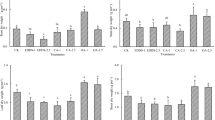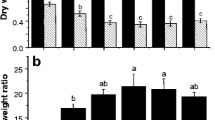Abstract
Enhanced phytoextraction of metals using amendments and hyperaccumulator plants is a promising alternative to expensive traditional remediation techniques. The present study comprehensively investigated the effects of six amendments on both mobility and phytoextraction of Cd and the feasibility of integrating amendment with Ramie as a hyperaccumulator plant on Cd-contaminated soil remediation. The leaching of Cd from contaminated soil was significantly enhanced by two chelating agents (i.e., ethylenediaminetetraacetic acid (EDTA) and ethyleneglycoltetraacetic acid (EGTA)), followed by two natural organic acids (i.e., citric acid and tartaric acid), and lastly, two rhizobacteria (i.e., Bacillus subtilis and Pseudomonas fluorescens). Further, the application of EDTA and EGTA had inhibitory effects on the growth of Ramie. The application of two organic acids and two rhizobacteria increased the dry biomass yields of roots, stems, and leaves. In terms of the dry biomass of Ramie, 32.7, 23.4, 50.6, and 53.1% of increases were obtained from the applications of citric acid, tartaric acid, B. subtilis, and P. fluorescens, respectively, as compared with that without any amendment applied. Meanwhile, the applications of all amendments were observed to increase Cd concentrations in aerial parts of the plants, and they were ranked in descending order of Cd accumulation: EDTA > EGTA > tartaric acid > citric acid > B. subtilis ≈ P. fluorescens. Taking Cd removal efficiency, potential environmental risk, and economic factor into consideration, EDTA and citric acid-enhanced phytoremediation using Ramie were feasible and promising approaches for remediating Cd-contaminated soil in real practice.







Similar content being viewed by others
Data Availability
The datasets generated during and/or analyzed during the current study are available from the corresponding author on reasonable request.
References
Ahmad, A., Ghufran, R., & Zularisam, A. (2011). Phytosequestration of metals in selected plants growing on a contaminated Okhla industrial areas, Okhla, New Delhi, India. Water Air & Soil Pollution, 217(1), 255–266.
Al-Shammary, A. A. G., Kouzani, A. Z., Kaynak, A., Khoo, S. Y., Norton, M., & Gates, W. (2018). Soil bulk density estimation methods: A review. Pedosphere, 28(4), 581–596.
Beiyuan, J., Tsang, D. C., Valix, M., Zhang, W., Yang, X., Ok, Y. S., & Li, X.-D. (2017). Selective dissolution followed by EDDS washing of an e-waste contaminated soil: Extraction efficiency, fate of residual metals, and impact on soil environment. Chemosphere, 166, 489–496.
Chandra, R., Kumar, V. & Singh, K., (2017). Hyperaccumulator versus nonhyperaccumulator plants for environmental waste management. In Phytoremediation of environmental pollutants (pp. 43–80). CRC Press.
Dakora, F. D., & Phillips, D. A. (2002). Root exudates as mediators of mineral acquisition in low-nutrient environments. Food Security in Nutrient-Stressed Environments: Exploiting Plants’ Genetic Capabilities, 201–213.
Dhaliwal, S. S., Singh, J., Taneja, P. K., & Mandal, A. (2020). Remediation techniques for removal of heavy metals from the soil contaminated through different sources: A review. Environmental Science and Pollution Research, 27(2), 1319–1333.
Dinu, C., Vasile, G.-G., Buleandra, M., Popa, D. E., Gheorghe, S., & Ungureanu, E.-M. (2020). Translocation and accumulation of heavy metals in Ocimum basilicum L. plants grown in a mining-contaminated soil. Journal of Soils and Sediments, 20(4), 2141–2154.
Gitari, M., Akinyemi, S., Thobakgale, R., Ngoejana, P., Ramugondo, L., Matidza, M., Mhlongo, S., Dacosta, F., & Nemapate, N. (2018). Physicochemical and mineralogical characterization of Musina mine copper and New Union gold mine tailings: Implications for fabrication of beneficial geopolymeric construction materials. Journal of African Earth Sciences, 137, 218–228.
Hao, W.-y, Ren, L.-x, Ran, W., & Shen, Q.-r. (2010). Allelopathic effects of root exudates from watermelon and rice plants on Fusarium oxysporum f. sp. niveum. Plant and Soil, 336(1), 485–497.
Hasan, M., Uddin, M., Ara-Sharmeen, I., Alharby, H. F., Alzahrani, Y., Hakeem, K. R., & Zhang, L. (2019). Assisting phytoremediation of heavy metals using chemical amendments. Plants, 8(9), 295.
Jiang, M., Liu, S., Li, Y., Li, X., Luo, Z., Song, H., & Chen, Q. (2019). EDTA-facilitated toxic tolerance, absorption and translocation and phytoremediation of lead by dwarf bamboos. Ecotoxicology and Environmental Safety, 170, 502–512.
Jiang, Y., Lei, M., Duan, L., & Longhurst, P. (2015). Integrating phytoremediation with biomass valorisation and critical element recovery: A UK contaminated land perspective. Biomass and Bioenergy, 83, 328–339.
Kampa, M., & Castanas, E. (2008). Human health effects of air pollution. Environmental Pollution, 151(2), 362–367.
Kumar, M., Furumai, H., Kasuga, I., & Kurisu, F. (2020). Metal partitioning and leaching vulnerability in soil, soakaway sediments, and road dust in the urban area of Japan. Chemosphere, 252, 126605.
Li, L., & Yi, H. (2020). Photosynthetic responses of Arabidopsis to SO2 were related to photosynthetic pigments, photosynthesis gene expression and redox regulation. Ecotoxicology and Environmental Safety, 203, 111019.
Lin, Z., Schneider, A., Nguyen, C., & Sterckeman, T. (2014). Can ligand addition to soil enhance Cd phytoextraction? A mechanistic model study. Environmental Science and Pollution Research, 21(22), 12811–12826.
Ling, N., Raza, W., Ma, J., Huang, Q., & Shen, Q. (2011). Identification and role of organic acids in watermelon root exudates for recruiting Paenibacillus polymyxa SQR-21 in the rhizosphere. European Journal of Soil Biology, 47(6), 374–379.
Liu, X., Fan, Y., Long, J., Wei, R., Kjelgren, R., Gong, C., & Zhao, J. (2013). Effects of soil water and nitrogen availability on photosynthesis and water use efficiency of Robinia pseudoacacia seedlings. Journal of Environmental Sciences, 25(3), 585–595.
Lu, H., Qiao, D., Han, Y., Zhao, Y., & Wang, Y. (2021). Low molecular weight organic acids increase cd accumulation in sunflowers through increasing Cd bioavailability and reducing Cd toxicity to plants. Minerals, 11(3), 243.
Meena, M., Swapnil, P., Divyanshu, K., Kumar, S., Tripathi, Y. N., Zehra, A., Marwal, A., & Upadhyay, R. S. (2020). PGPR-mediated induction of systemic resistance and physiochemical alterations in plants against the pathogens: Current perspectives. Journal of Basic Microbiology, 60(10), 828–861.
Meers, E., Tack, F., Van Slycken, S., Ruttens, A., Du Laing, G., Vangronsveld, J., & Verloo, M. (2008). Chemically assisted phytoextraction: A review of potential soil amendments for increasing plant uptake of heavy metals. International Journal of Phytoremediation, 10(5), 390–414.
Meharg, A. A., Norton, G., Deacon, C., Williams, P., Adomako, E. E., Price, A., Zhu, Y., Li, G., Zhao, F.-J., & McGrath, S. (2013). Variation in rice cadmium related to human exposure. Environmental Science & Technology, 47(11), 5613–5618.
Mehmood, S., Imtiaz, M., Bashir, S., Rizwan, M., Irshad, S., Yuvaraja, G., Ikram, M., Aziz, O., Ditta, A., & Rehman, S. U. (2019). Leaching behavior of Pb and Cd and transformation of their speciation in co-contaminated soil receiving different passivators. Environmental Engineering Science, 36(6), 749–759.
Mohanty, M., & Patra, H. K. (2012). Effect of chelate-assisted hexavalent chromium on physiological changes, biochemical alterations, and chromium bioavailability in crop plants—An in vitro phytoremediation approach. Bioremediation Journal, 16(3), 147–155.
Rahman, Z., & Singh, V. P. (2019). The relative impact of toxic heavy metals (THMs)(arsenic (As), cadmium (Cd), chromium (Cr)(VI), mercury (Hg), and lead (Pb)) on the total environment: An overview. Environmental Monitoring and Assessment, 191(7), 1–21.
Rinklebe, J., & Shaheen, S. M. (2014). Assessing the mobilization of cadmium, lead, and nickel using a seven-step sequential extraction technique in contaminated floodplain soil profiles along the central Elbe River, Germany. Water Air & Soil Pollution, 225(8), 1–20.
Rostami, S., & Azhdarpoor, A. (2019). The application of plant growth regulators to improve phytoremediation of contaminated soils: A review. Chemosphere, 220, 818–827.
Rungwa, S., Arpa, G., Sakulas, H., Harakuwe, A., & Timi, D. (2013). Phytoremediation–an eco-friendly and sustainable method of heavy metal removal from closed mine environments in Papua New Guinea. Procedia Earth and Planetary Science, 6, 269–277.
Sarwar, N., Imran, M., Shaheen, M. R., Ishaque, W., Kamran, M. A., Matloob, A., Rehim, A., & Hussain, S. (2017). Phytoremediation strategies for soils contaminated with heavy metals: Modifications and future perspectives. Chemosphere, 171, 710–721.
She, W., Jie, Y.-C., Xing, H.-C., Luo, Z.-Q., Kang, W.-L., Huang, M., & Zhu, S.-J. (2011). Absorption and accumulation of cadmium by ramie (Boehmeria nivea) cultivars: A field study. Acta Agriculturae Scandinavica Section B-Soil & Plant Science, 61(7), 641–647.
Sun, Y., Sun, G., Xu, Y., Liu, W., Liang, X., & Wang, L. (2016). Evaluation of the effectiveness of sepiolite, bentonite, and phosphate amendments on the stabilization remediation of cadmium-contaminated soils. Journal of Environmental Management, 166, 204–210.
Sun, Y., Zhou, Q., & Diao, C. (2008). Effects of cadmium and arsenic on growth and metal accumulation of Cd-hyperaccumulator Solanum nigrum L. Bioresource Technology, 99(5), 1103–1110.
Tang, J., He, J., Liu, T., Xin, X., & Hu, H. (2017). Removal of heavy metal from sludge by the combined application of a biodegradable biosurfactant and complexing agent in enhanced electrokinetic treatment. Chemosphere, 189, 599–608.
Tao, Q., Zhao, J., Li, J., Liu, Y., Luo, J., Yuan, S., Li, B., Li, Q., Xu, Q., & Yu, X. (2020). Unique root exudate tartaric acid enhanced cadmium mobilization and uptake in Cd-hyperaccumulator Sedum alfredii. Journal of Hazardous Materials, 383, 121177.
Udovic, M., & Lestan, D. (2012). EDTA and HCl leaching of calcareous and acidic soils polluted with potentially toxic metals: Remediation efficiency and soil impact. Chemosphere, 88(6), 718–724.
Wang, S., & Liu, J. (2014). The effectiveness and risk comparison of EDTA with EGTA in enhancing Cd phytoextraction by Mirabilis jalapa L. Environmental Monitoring and Assessment, 186(2), 751–759.
Wang, Y., Li, F., He, Q., Bao, Z., Zeng, Z., & An, D. (2021). Genomic analyses provide comprehensive insights into the domestication of bast fiber crop ramie (Boehmeria nivea). The Plant Journal, 107(3), 787–800.
Wen, Y., Li, W., Yang, Z., Zhang, Q., & Ji, J. (2020). Enrichment and source identification of Cd and other heavy metals in soils with high geochemical background in the karst region. Southwestern China Chemosphere, 245, 125620.
Wu, Z., Tang, Q., Wang, Y., Qiu, C., Long, S., Zhao, X., Hu, Z. & Guo, Y., (2021). Ramie (Boehmeria Nivea) as Phytoremediation Crop for Heavy Metal-contaminated Paddy Soil in Southern China: Variety Comparison, Cd Accumulation, and Assessment of Fiber Recycling. Journal of Natural Fibers, pp. 1–14.
Yang, Q., Li, Z., Lu, X., Duan, Q., Huang, L., & Bi, J. (2018). A review of soil heavy metal pollution from industrial and agricultural regions in China: Pollution and risk assessment. Science of the Total Environment, 642, 690–700.
Funding
This work was financially supported by the Guangzhou Science and Technology Planning Project (202002030313) and Shenzhen Sustainable Development Innovation Programme (Grant No. KCXFZ20201221173211031).
Author information
Authors and Affiliations
Corresponding authors
Ethics declarations
Conflict of Interest
The authors declare no competing interests.
Additional information
Publisher's Note
Springer Nature remains neutral with regard to jurisdictional claims in published maps and institutional affiliations.
Supplementary Information
Below is the link to the electronic supplementary material.
Rights and permissions
Springer Nature or its licensor holds exclusive rights to this article under a publishing agreement with the author(s) or other rightsholder(s); author self-archiving of the accepted manuscript version of this article is solely governed by the terms of such publishing agreement and applicable law.
About this article
Cite this article
Zhang, Z., Zhang, H., Woon, K.S. et al. Amendment-Enhanced Phytoextraction of Cadmium from Contaminated Soil Integrating with Ramie as Hyperaccumulator Plant. Water Air Soil Pollut 233, 373 (2022). https://doi.org/10.1007/s11270-022-05843-y
Received:
Accepted:
Published:
DOI: https://doi.org/10.1007/s11270-022-05843-y




